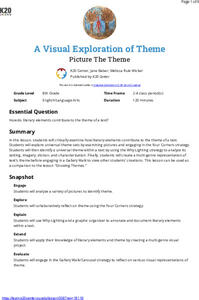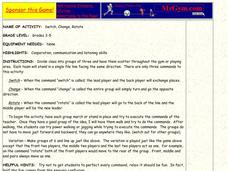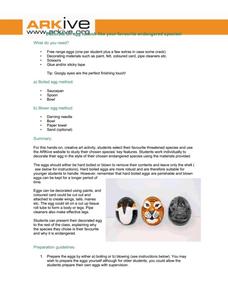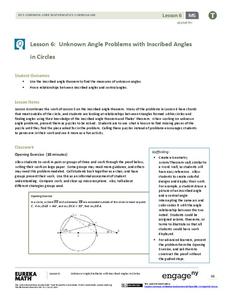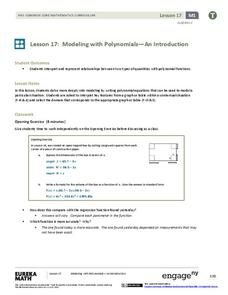Curated OER
Pack your Parfleche!
Imagine you are a Plains Indian, a nomad getting ready to follow a herd of buffalo. Now imagine what you would have to pack for your trip. Little ones examine images of a traditional parfleche (packing box), and then create packing lists...
K20 LEARN
A Visual Exploration Of Theme: Picture The Theme
"What is the theme of this story?" Now there's a question that can strike fear in the hearts of learners. Here's a lesson that uses photographs to introduce the concept of theme. Scholars examine six photographs and then attach a theme...
Curated OER
Who Was That Man?
Develop historical analysis and interpretation with your older students. They will study and analyze three given interpretations of Christopher Columbus' life, which includes significant events, his character, and the impact he made on...
Curated OER
Lesson: Who Are You Supposed to Be?
A new way to connect visual art and creative writing is on the horizon. Kids first identify the characters in the painting Rabbit Hunt, then write narrative from the perspective of one of the characters in the painting. They combine...
Curated OER
Reply to a Job Ad
So, you've just spotted an ad for the perfect job, now what? Get kids ready to enter the workforce by having them practice the first step, replying to a job ad. They scan the paper for a job, role-play responding to the ad via phone,...
Curated OER
Multiplication is Commutative
Your class knows about the commutative property of addition - now introduce them to the commutative property of multiplication. They review the concept, work through some examples, then try a few problems out on their own. One property...
Curated OER
Each Orange Had 8 Slices
If you haven't read Each Orange Had 8 Slices with your young mathematicians, now is the time! Ideal for beginners to multiplication, this book features several number stories, and challenges learners to answer math questions....
Curated OER
Found Poem: Number the Stars
It's easy to write a found poem! First, select a passage about 50-100 words in length. Then, select only the strong, visual language. Now you're ready to write your found poem: simply string the words together adding (at most) two of...
Curated OER
First-aid Safety Skills
Everyone gets minor cuts and scrapes now and then. Provide your special education class with the skills they needs to clean and bandage a small wound. Use read marker (fake blood) on your arm and show your class how to wash and dress it....
Curated OER
Student Handout - Situations
Everybody misses work now and then, or runs a little late. Prepare your special needs class with practice communicating their difficulties in getting up and getting to work. They look at each of the six scenarios, describe them and...
PBS
The Butterfly or Adult
Now that your class knows about the life cycle of a butterfly, it's time to discuss how an adult butterfly survives in the wild. The class diagrams and labels the parts of a butterfly, discusses how butterflies survive, and then make a...
Mr Gym
Switch, Change, Rotate
Switch, change, rotate! Players are in groups of three scattered around the playing area. Switch means the lead and back players change positions. Change means the entire group turns and goes in the opposite direction. Rotate means the...
ARKive
Endangered Animal Easter Eggs
I love any lesson that addresses more than one subject area. You and your class will discuss endangered animals; each child will choose one animal and then create a decorated egg to represent their animal. After the eggs are decorated,...
Indian Land Tenure Foundation
A Sense of Belonging
In order to understand how the land changes over time because of the people who live there, learners interview an elderly person about the past. Children ask an older family member to describe what the local area was like when they were...
Film English
Paper Is Not Dead
Now that much of people's lives center around their electronic devices, paper is being used less often. However, sometimes you do need paper. Have your class brainstorm the uses of paper and of electronic devices and compare their...
Virginia Department of Education
The Hydrologic Cycle
There is the same amount of water on earth now as there was when it was formed. The water from your faucet could contain molecules that dinosaurs drank! Young scientists build their own hydrologic cycle model and observe...
EngageNY
Unknown Angle Problems with Inscribed Angles in Circles
We know theorems about circles—now what? Class members prove a theorem, with half the class taking the case where a point is inside the circle and half the class taking the case where a point is outside the circle. The lesson then...
EngageNY
Modeling with Polynomials—An Introduction (part 2)
Linear, quadratic, and now cubic functions can model real-life patterns. High schoolers create cubic regression equations to model different scenarios. They then use the regression equations to make predictions.
EngageNY
Trigonometry and Complex Numbers
Complex numbers were first represented on the complex plane, now they are being represented using sine and cosine. Introduce the class to the polar form of a complex number with the 13th part of a 32-part series that defines the...
Balanced Assessment
Sloppy Student I
"Does this work every time?" We've all heard it. Now learners get to explore methods to answer that question themselves. Pupils analyze a mistake that has been made with creating a formula for multiplying binomials. They then create...
Polar Trec
Arctic Smorgasbord!
Two blooms of phytoplankton, instead of just one, now occur in the Arctic due to declining sea ice, which will have widespread effects on the marine life and climate. In small groups, participants build an Arctic food web with given...
PhysEdGames
Blob Tag
Have the class line up on one side of the gym. Choose one person to be the tagger. When the tagger yells "blob tag!" then the whole class runs across the gym while trying not to get tagged. Anyone that's tagged, now becomes part of the...
PhysEdGames
Skunk Tag
Choose two taggers to be the "skunks." Set up five hula hoops in the gym; one in each corner and one in the middle. The hoops in the corners are the safe zones for the players while the middle hoop is the skunk's home. The skunks start...
Norwich University
Seven Man-Made Engineering Wonders of the Ancient World
Imagine precisely cutting and then moving a 120 ton boulder more than two miles without mechanical cutting tolls, skid loaders, or hydraulic cranes. Imagine carving a stone figure that includes a drainage system that permits rainwater to...
Other popular searches
- Transportation Then and Now
- Families Then and Now
- That Was Then This Is Now
- Now and Then
- Medicine Then and Now
- School Then and Now
- Schools Then and Now
- Thanksgiving Then and Now
- America Then and Now
- Now and Then Clothing
- Now and Then Movie
- Communities Then and Now

